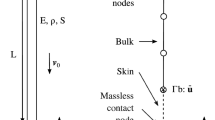Abstract
The paper deals with simulation of mechanical systems affected by discontinuous phenomena. These phenomena involve impulsive events and/or models whose structure changes depending on the values of some system variables. The models of three kinds of these discontinuities (joint with static friction, collisions with rigid environment, bifurcation behavior near kinematic singularities) are given, and a simulation environment, based on the DAE solver DASSL is presented, that also allows efficient simulation of sample-data systems. Some simulation results achieved with the proposed environment are finally presented.
Similar content being viewed by others
Explore related subjects
Discover the latest articles, news and stories from top researchers in related subjects.References
Burdick, J. W.: An algorithm for generation of efficient manipulator dynamic equations, Proc. IEEE Int. Conf. on Robotics and Automation, San Francisco, 1986.
Khalil, W.: SYMORO: Systeme Pour la Modelisation des Robots, ENMS-LAN, Nantes, 1989.
Vukobratovic, M., Kircanski, N., Timcenko, A., and Kircanski, M.: SYM — program for computer-aided generation of optimal symbolic models of robot manipulators, in W. Schiehlen (ed.), Multibody Systems Handbook, Springer-Verlag, 1989.
Armstrong-Hélouvry, B.: Control of Machines with Friction, Kluwer Academic Publishers, Dordrecht, 1991.
Uran, S., Jezernik, K. and Troch, I.: Coulomb friction and simulation problems, in Proc. SYROCO'91, Wien, 1991, pp. 33–38.
Zheng, Y. F. and Hemami, H.: Mathematical modeling of a robot in collision with its environment, Journal of Robotic Systems 2(3) (1985), 289–307.
Ferretti, G., Maffezzoni, C. and Magnani, G.: Dynamic simulation of robots interacting with stiff contact surfaces, Trans. Soc. for Computer Simulation 9(1) (1992), 1–24.
McClamroch, N. H. and Wang, D.: Feedback stabilization and tracking of constrained robots, IEEE Trans. on Automatic Control 33 (1988), 419–426.
Haug, E. J.: Computer-Aided Kinematics and Dynamics of Mechanical Systems, Allyn and Bacon, 1989.
Ellis, R. E., Ricker, S. L.: Two numerical issues in simulating constrained dynamics, in Proc. IEEE Int. Conf. on Robotics and Automation, Nice, France, 1992, pp. 312–318.
Brenan, K. E., Campbell, S. L. and Petzold, L. R.: Numerical solution of Initial-Value problems in Differential-algebraic equations, Elsevier Science, 1989.
The Math. Works, SIMULINK User's Guide, 1992.
Bellasio, F., Benvenuti, A., Lluka, P., Groppelli, G. and Maffezzoni, C.: A modular simulation environment based on object-oriented database technology, in Proc. European Control Conf., Groningen, 1993, pp. 1568–1574.
Author information
Authors and Affiliations
Rights and permissions
About this article
Cite this article
Ferretti, G., Maffezzoni, C., Magnani, G. et al. Simulating discontinuous phenomena affecting robot motion. J Intell Robot Syst 15, 53–65 (1996). https://doi.org/10.1007/BF00435727
Received:
Issue Date:
DOI: https://doi.org/10.1007/BF00435727




